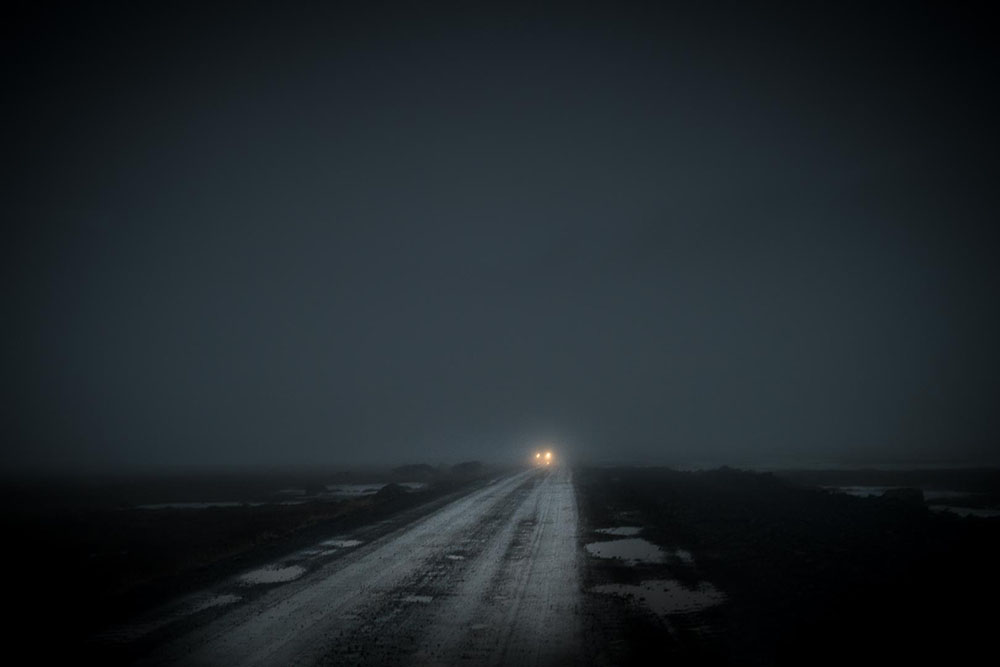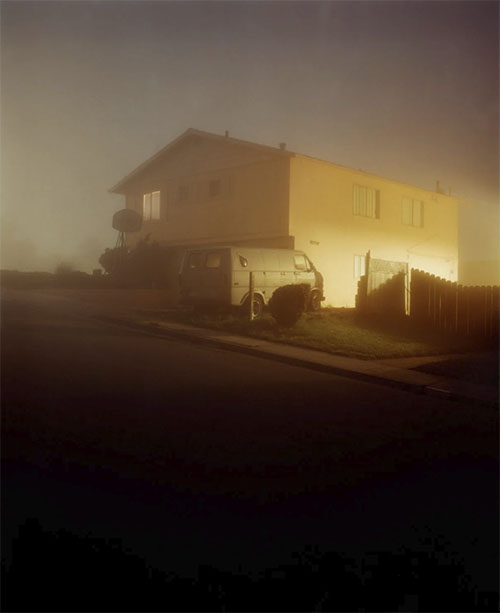Download: Poet of Exurban Noir
by Renny Pritikin

Todd Hido’s retrospective-scale exhibition, organized by Casemore Gallery, takes full advantage of the spacious former McEvoy Foundation space in the Minnesota Street complex. With over 100 photographs, its various ambitions can be gleaned from the unwieldy title: Some Polar Expiation, an Enormous Cat, a Complete Collection of Cinematic Houses at Night, a Starlet, a Mentor, some Assorted Reveries & a Message from the Future.
Some Polar begins by acknowledging the artist’s mentor, Larry Sultan (1946-2009). As an homage, Hido hung Sultan’s 1984 photograph, Dad on Bed, near the entryway above wall text asserting that, without Sultan, his career might never have happened. Among the many things he learned from Sultan was “the places that families inhabit can in fact be just as powerful and revealing” as a portrait. That strategy — of emphasizing context and nuance over explicit statement — helps as we negotiate a large installation in which external views of houses, panoramas of forests, deserted icy landscapes and empty rooms take their power from the unseen presence of humanity. The salon-style exhibition includes samples from almost all of Hido’s 30-year career, minus his provocative portraits of women which inexplicably go missing.

The artist was born in Ohio in 1968 but has spent his adult life in the Bay Area, where he received an MFA from CCA after studying at Tufts in Massachusetts for his undergraduate degree. His achievements are notable: 18 books and work in major collections, including the LA County Museum, SFMOMA and the Whitney Museum of American Art. He considers Nan Goldin, Rineke Dijkstra, Emmet Gowin and Andreas Gursky as both peers and influences.
Hido is perhaps best known for a series called House Hunting, shown here in a long, narrow grid of 45 images. They appear in the last gallery, as if the artist wanted to de-emphasize them the way a pop star might downplay his greatest hits. Many critics think of these photos as movie stills, but I don’t. I see them as something akin to evidence introduced in a Kafkaesque trial in which the accused and their alleged crimes go unnamed. Such enigmas are the essence of Hido’s art. His images stand as some of the most affecting from the turn-of-the-century period.
To record them, Hido haunted suburban Bay Area towns late at night and documented individual homes from a medium distance. The resulting color photographs are redolent of silence and isolation; in observing them, we become something akin to the homeless stranger — out in the cold, uninvited. The sheer separateness of the houses is harrowing. inducing a bone-chilling sadness that, once perceived, can’t be shaken. Hido doesn’t title his photographs; he assigns them numbers. As with most of the House Hunting series, # 11669-3036 shows an isolated suburban dwelling in the evening, seen from across a snowy street, with two lonely windows internally lit, one yellow and one red, as if sending a coded message to passersby. # 11851-3645 isn’t part of House Hunting, but could be. It shows a frigid rural road cutting through a snowy field at dusk; houses that should be there appear to have been erased from the scene.
Hido handles forests and landscapes similarly, showing woodlands from a distance, across open fields. They may strive toward objectivity yet evoke a strong emotional response. # 12171-2747, dominated by the setting sun reflected in a lake, could depict a nuclear explosion on the horizon. The power of that suggestion is balanced by the heartbreaking emptiness of the scene. Similarly, in # 12011-5478, a pink-and-orange sunset at the horizon line is silently “observed” by a line of trees, their trunks immersed in snow,

gathered like people watching a celestial event such as our recent solar eclipse. My favorite is # 12077-0184 where the moon, the only light source, hides behind clouds, partially obscured by a cluster of nearly denuded trees whose sharp-edged branches evoke the precision of cut-paper imagery. # 11682-5547, shot during a snowstorm, shows each papery flake lit like a lantern.
When walking, I enjoy noting snatches of conversation I overhear between passersby — they often form a kind of found poetry. Something similar happens in several Hido works that depart from his usual fare of houses and forests. Untitled (collage), for example, depicts three dozen items placed randomly within the frame. They range from a sign (“Tooth and Nail”) to a snapshot from the 1930s of several people in a rowboat to an amateur painting of a woman with rosy cheeks and mismatched eyes. These random bits of information form a composite narrative of mid-century American life. Hido amplifies that notion by including a few well-chosen poems. One by Robert Creeley reads: “One day after another–/Perfect./They all fit.” He counterbalances the sweetness of that poem with another from Emily Dickinson that reflects the overall darkness of his oeuvre: “I tried to think a lonelier Thing/than any I had seen – /Some Polar Expiation – An Omen in the Bone/Of Death’s tremendous nearness –”

An early work from 1996 stands apart from all that. It shows a long-haired white cat sitting on a thick brown carpet before a wall of fake wood paneling. It glares at us with yellow eyes, made larger than life-size in the six-foot- tall print. It looks as artificial as the environment it inhabits. It is, in fact, the only living thing we encounter in Hido’s universe of seemingly abandoned tract homes. One image of an empty red pickup truck parked on a snowy hilltop dirt road sums up Hido’s essential proposition: that we’re stuck on an endless road to nowhere in a driverless car, surrounded by emptiness. Another stinging image brings us to the unlikely (but real) intersection of Locust Avenue and Locust Avenue, a geographic non sequitur Hido couldn’t resist documenting.
Untitled Video #1, a two-minute loop situated in a separate room, pictures a suburban house seen through the rain-streaked windshield of an idling car. After a while, it pulls away and drives down a nondescript residential street, the camera continuing to look ahead. Simple as that is, it suggests a deeply felt familial event, like those depicted in 1950s Douglas Sirk melodramas. When I entered the space, another visitor was quietly crying in the dark. Hido’s approach— a mixture of loneliness, moonlight and empty space—taps into the noir-ish post WWII American psyche as well as any artist of his generation.
# # #
Todd Hido: “Some Polar Expiation, an Enormous Cat, a Complete Collection of Cinematic Houses at Night, a Starlet, a Mentor, some Assorted Reveries & a Message from the Future” @ Casemore Gallery through June 29, 2024.
Note: The exhibition is located at 1150 25th St., the former site of McEvoy Foundation – not Casemore’s Minnesota St. location.
About the author: Renny Pritikin was the chief curator at The Contemporary Jewish Museum in San Francisco from 2014 to 2018. Before that, he was the director of the Richard Nelson Gallery at UC Davis and the founding chief curator at Yerba Buena Center for the Arts beginning in 1992. For 11 years, he was also a senior adjunct professor at California College of the Arts, where he taught in the graduate program in Curatorial Practice. Pritikin has given lecture tours in museums in Japan as a guest of the State Department, in New Zealand as a Fulbright Scholar, and visited Israel as a Koret Israel Prize winner. The Prelinger Library published his most recent book of poems, Westerns and Dramas, in 2020. He is the United States correspondent for Umbigo magazine in Lisbon, Portugal and the author of a recently published memoir, At Third and Mission: A Life Among Artists.
I love Noir ( the books) and I love Todd Hido’s work. I had not made the connection untill I read this article.